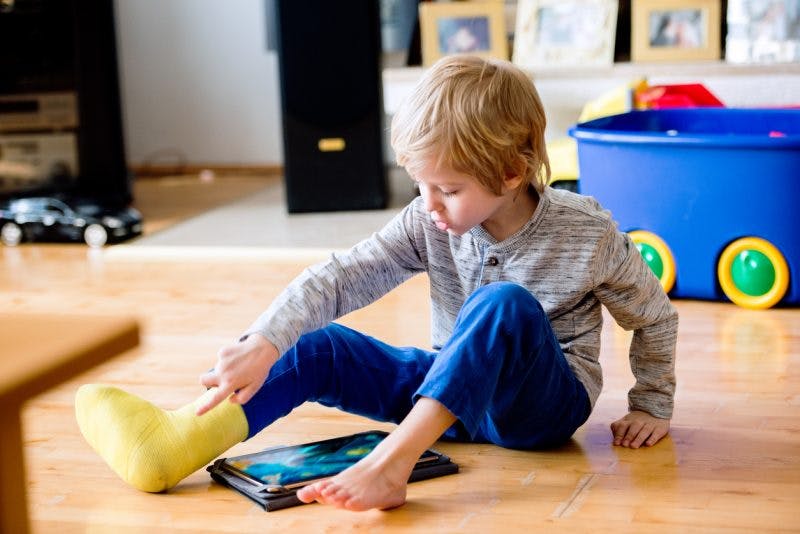Serial casting is a non-invasive form of spasticity treatment that works to gently stretch contracted muscles over a set period of time. It can help individuals with cerebral palsy prevent further tightening of the muscles, which may help reduce pain and encourage mobility.
To help you understand what serial casting is and how it can help individuals with cerebral palsy, this article will discuss:
What is Serial Casting?
Serial casting is used for children with cerebral palsy that have shortened muscles due to spasticity. When muscles stay contracted, they limit the joint’s range of motion, which results in stiff movements.
Serial casting holds the joint in place so that there is slight tension on the muscle. This tension will gradually make the muscle longer and more flexible. It’s most commonly used for the ankle area, but can also be used for the knees, elbows, wrists, or fingers.
The goal of serial casting is to increase range of motion and lengthen contracted muscles through subtle, prolonged stretching. It ensures that the muscle is constantly being stretched, even when your child isn’t doing anything. This is called passive stretching and it helps prevent spastic muscles from further tightening throughout the day.
Often, spastic muscles can pull the limbs into abnormal positions and negatively impact an individual’s movement patterns. Serial casting provides musculoskeletal support to ensure the limbs stay in place and prevent the development of poor form.
The cast will gently stretch the muscles, so it should not be painful. As you continue to maintain a stretch, the amount of tension decreases, which allows the muscle fibers to lengthen. Each time that the cast is replaced, the muscle can be stretched further.
How Long is the Serial Casting Process?

Serial casting is non-invasive, making it ideal for children. It’s a gradual process that may provide changes for several weeks or months.
Generally, the cast is replaced every 7 days for a period of up to 12 weeks. However, the cast can be replaced slightly earlier or later depending on the severity of the individual’s spasticity.
A study suggests that changing the cast within 5 days or less is optimal to the traditional 7 days because it reduces the potential for complications to develop and the consequent discontinuation of casting. For example, changing the cast more often can reduce the retention of moisture that can lead to skin irritations. Additionally, it may shorten the total serial casting intervention timeline.
What to Expect After Serial Casting
Initially, the cast might feel uncomfortable. It shouldn’t be painful, but it will add extra weight to the individual’s leg. However, individuals should adjust to the cast quickly and be able to function as they did before they got the cast. It’s recommended for individuals to be active while they have the cast on because it will help them adjust to walking with improved form.
Another caution to be aware of is that areas inside the cast may get itchy. To reduce itching, keep the cast dry. Moisture retention may cause blistering or pressure sores. Additionally, prevent your child from sticking anything inside the cast to relieve the itchiness. This may further irritate the skin or even cause items to get stuck inside the cast.
A cast is generally low maintenance, but it does need to stay dry. Children will need to wrap their cast with plastic wrap, secure it with medical tape, and place a plastic bag around it when they bathe. Even though it is covered, the limb with the cast should never go in the water.
Can Serial Casting Treat Spasticity Long-Term?

The effects of serial casting are not permanent and will require maintenance after the cast is removed. Your child’s doctor may advise wearing a brace overnight. Braces can be taken on and off throughout the day and will help maintain your child’s range of motion.
As previously mentioned, serial casting may last up to 12 weeks, and the continuous stretching will lengthen the muscle fibers. However, failure to continue stretching and exercising after the cast is removed may cause your muscles to shorten again.
It’s important to take advantage of the effects of serial casting and practice moving with correct form as much as you can to retain the improved function.
Serial Casting for Children with Cerebral Palsy
Serial casting is well-tolerated by most children because it is mild, gradual, and comes with minimal side effects if properly taken care of.
Casting helps promote correct musculoskeletal alignment and prevents the muscles from further tightening. Additionally, prolonged stretching will lengthen muscles to improve flexibility, range of motion, and gait.
We hope this article helped you better understand what serial casting is and how it can help individuals with cerebral palsy manage their spasticity.











